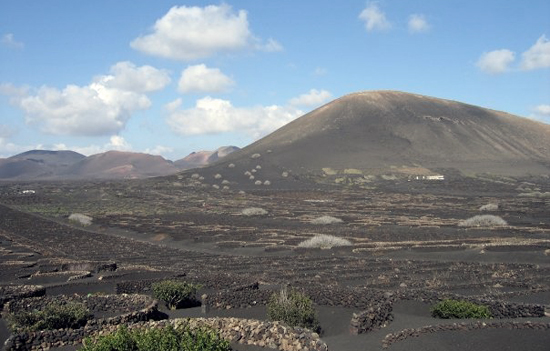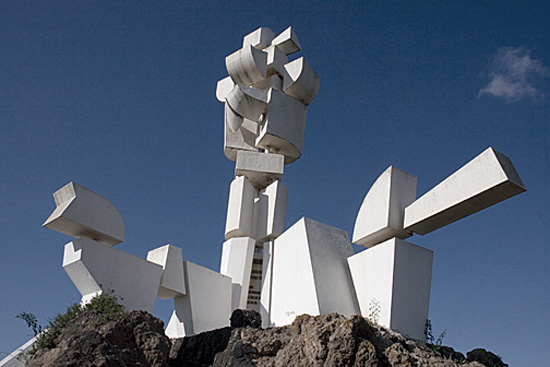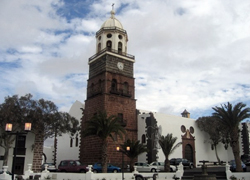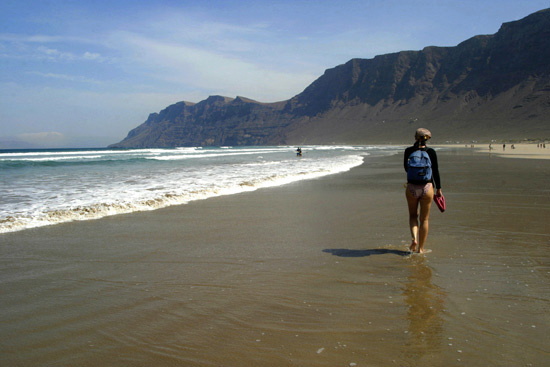Do not miss: The Geria, Monumento al Campesino, Teguise, Famara Fundación César Manrique.
Where to eat? International Cuisine Lagomar (Nazareth).
A dip: Famara (Playa Blanca).
For shooting: Set historic Teguise, Chinijo Archipelago (from Playa de Famara), Charco de San Gines and Balls Bridge (Arrecife)
The geographical centre of Lanzarote is known for its cultural surroundings. Within this area its inhabitants and their traditional economic activities are based upon agriculture and fishing however, we must also pay tribute to Cesar Manrique for his peculiar yet popular Monumento al Campesino. In addition, the ancient capital of the island, Teguise, and the current, Arrecife, are located on this stretch of land.

The natural environment in which life unfolds in the interior of the island can be significantly noticed in La Geria and Caleta de Famara. We would suggest that you began your route through the centre of Lanzarote with La Geria. It is a natural reserve, is unique and has an intoxicating landscape of volcanic ash that bathes the entire area and was caused by the volcanic eruption of Timanfaya between 1730 -1736. It is the largest vine growing area on Lanzarote and is the perfect wine route due to its natural surroundings. From the south to the north, the best are La Geria, Stratvs and El Grifo. Each with their own exquisite tasting rooms they have something to offer. Stratvs offer a cultural experience by teaching you verbally about the process of wine making. El Grifo informs you about the history of the island and demonstrates the old machinery that was used in the eighteenth century, whilst a visit to La Geria is where you get to taste and see the natural vastness of the vines themselves.

Close to El Grifo and in the centre of the island stands the Monumento a la Fecundidad. This was another creation of Cesar Manrique. The museum and the restaurant are comprised by a series of buildings that have been purposely created according to the prototype of Lanzarote. Here you can see things such as fireplaces, flower beds, wells, patios, carpentries, wineries etc. As always Manrique has hallmarked this beautiful place with contemplative nature. The resort features a traditional cuisine; you have the choice of its nearby restaurant or its independent tapas corner. Take the perfect opportunity to recharge those batteries especially having tasted the wines of La Geria and wash it down with some canarian potatoes, a portion of tasty octopus or some tuna belly.

From El Campesino we would suggest a visit towards Teguise simply because of its urban layout and its preserved architectural structure. Its historic cobblestone pedestrian walkway portrays a rustic feel matching your parsimonious day whilst its remarkable monuments and buildings express certainty within the world of culture. The walk through the old town is very pleasant and with thanks to the numerous shops, terraces and restaurants it is given a lease of life. El Convento de Santo Domingo and el Palacio de Spinola are highly recommended visiting points however, in our opinion the museum of Emigrante that stands within the grounds of the castle of Guanapay in the mountains of Santa Barbara is a visiting point that cannot be missed. In addition to its 16th century cultural location it has superb latitude views of the whole island.
One of the best viewpoints from the castle of Guanapay is that of Famara. On the western coastline of Lanzarote it is clear to see the vast expanse of sheltered natural sandy bays surrounded by haunting cliffs from the town itself as well as of the distant neighbouring archipelago islands of Chinijo, La Graciosa, Alegranza, and Montaña Clara. Due to its six kilometre beach, as well as that of Papagayo, it is in the best swimming area on the island. Its climatic atmosphere attracts mostly those who take part in adventure sports such as surfing and kite surfing however due to its sporting environment also attracts those who are walkers, play beach football, fly kites…… Caleta de Famara is a charming fishing village and along its promenade offers a varied cuisine based on fresh fish from its coastal shores.

Whilst Famara is purely for those who bathe we would also suggest a visit to Arrecife which is found by making your way from west to east through the centre of the island. A few kilometres from the capital, in Tahiche you will find the former residence of Cesar Manrique which today is the home of his foundation. Those who are art admirers must take the opportunity to visit the international museum of Arte Contemporaneo del Castillo de San Jose that is located on Arrecifes sea front. The city centre portrays historical values throughout the Castillo de San Gabriel (1742) which is formed by a fortress, by the legendary silhouette of the bridge of Las Bolas and the surrounding sailors marine of el Charco de San Gines.
Around this historical framework there is an attractive shopping centre on Leon y Castillo street.

Continuing along this road you will stumble across the beach of El Reducto which is situated next to Arrecife Gran Hotel. On the hotels 17th floor, from the coffee shop Stars City, you will experience some spectacular views of Arrecife’s marina. Otherwise, a drink in Arrecife in El Tambo, Buzo’s Bar or Tsunamis, all you will find are very welcoming.
